Abstract
The degradation of phosphatidylinositol bisphosphate (PIP2) to diacylglycerol and inositol trisphosphate is elicited by ligand-receptor interactions in many cell types, and may be involved in the induction of cell growth. The mitogens concanavalin A and anti-immunoglobulin antibodies have previously been shown to induce degradation of PIP2 in mouse thymocytes and B cells, respectively. We have now investigated the effects of the immunosuppressive peptide cyclosporine (CS) on this response, since CS appears to inhibit an early step in lymphocyte activation by mitogens that induce PIP2 degradation and Ca2+ mobilization. We found that CS, at doses that completely abrogated the proliferative responses, did not affect the degradation of inositol phospholipids in either thymocytes or B cells. We therefore conclude that if PIP2 degradation is implicated in lymphocyte activation, then CS does not interfere with the second messenger production initiated by PIP2 breakdown, but rather with a later event(s) elicited by this pathway.
Full text
PDF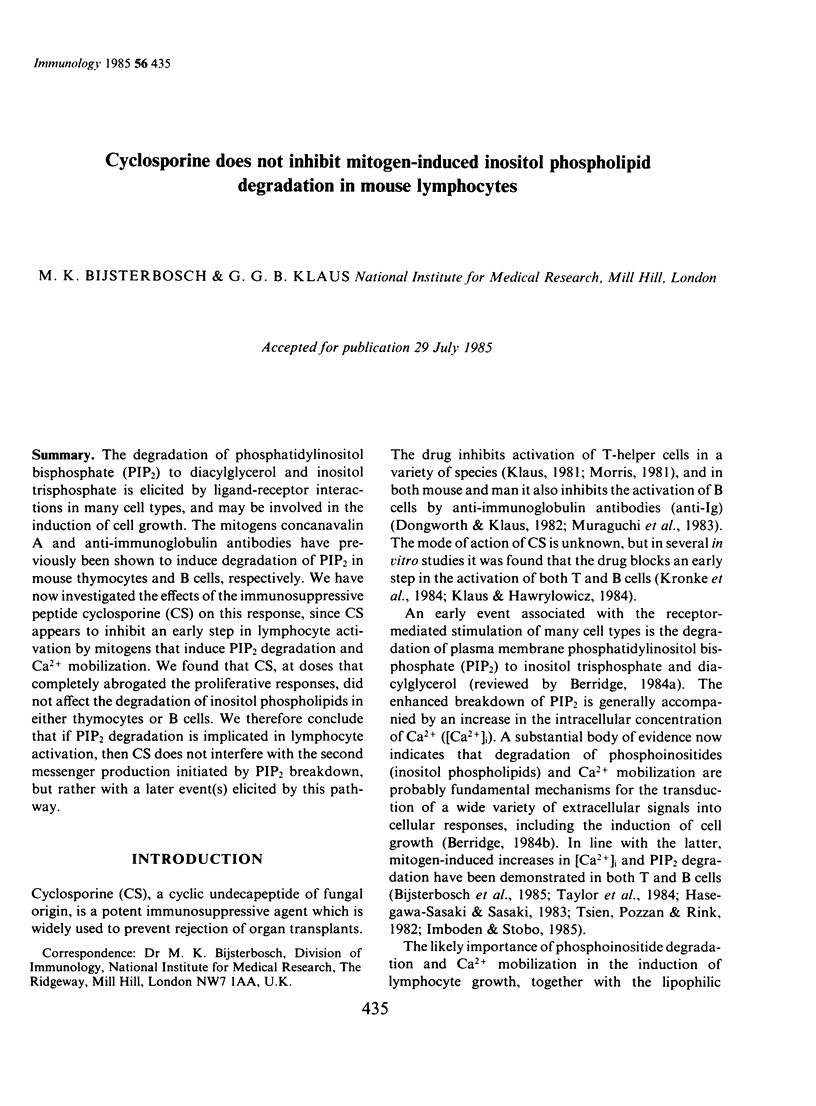
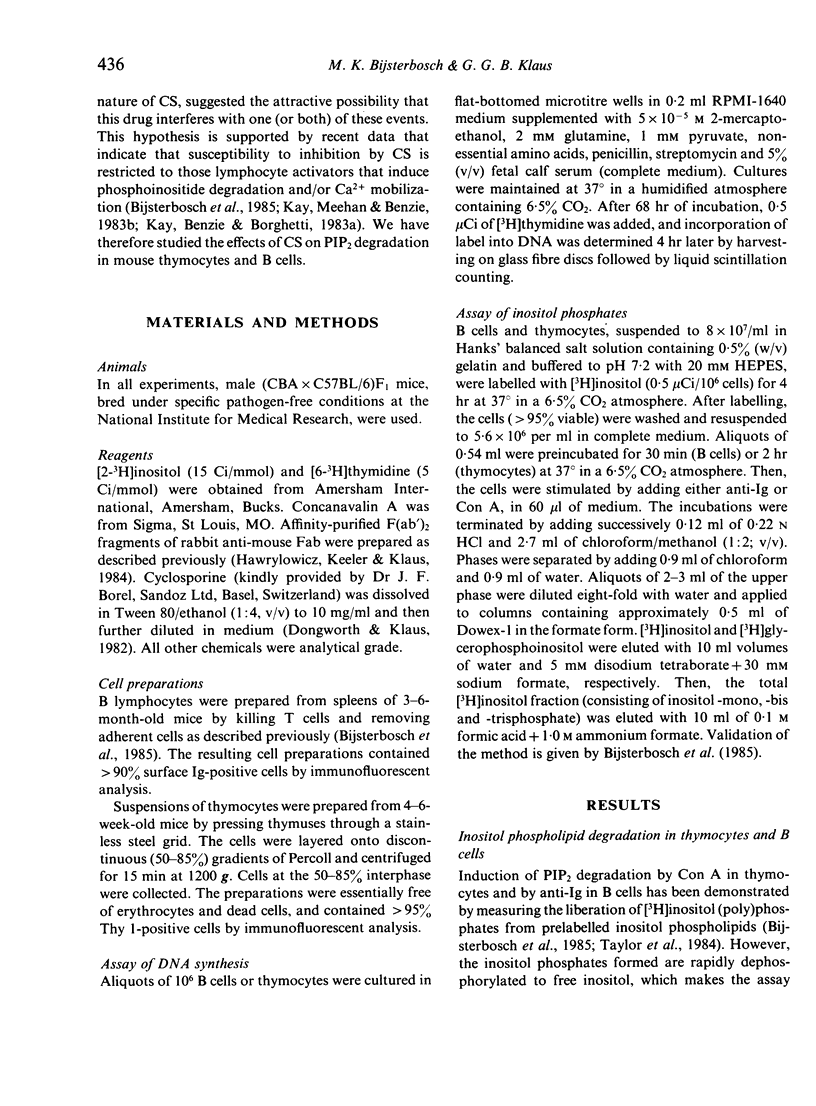
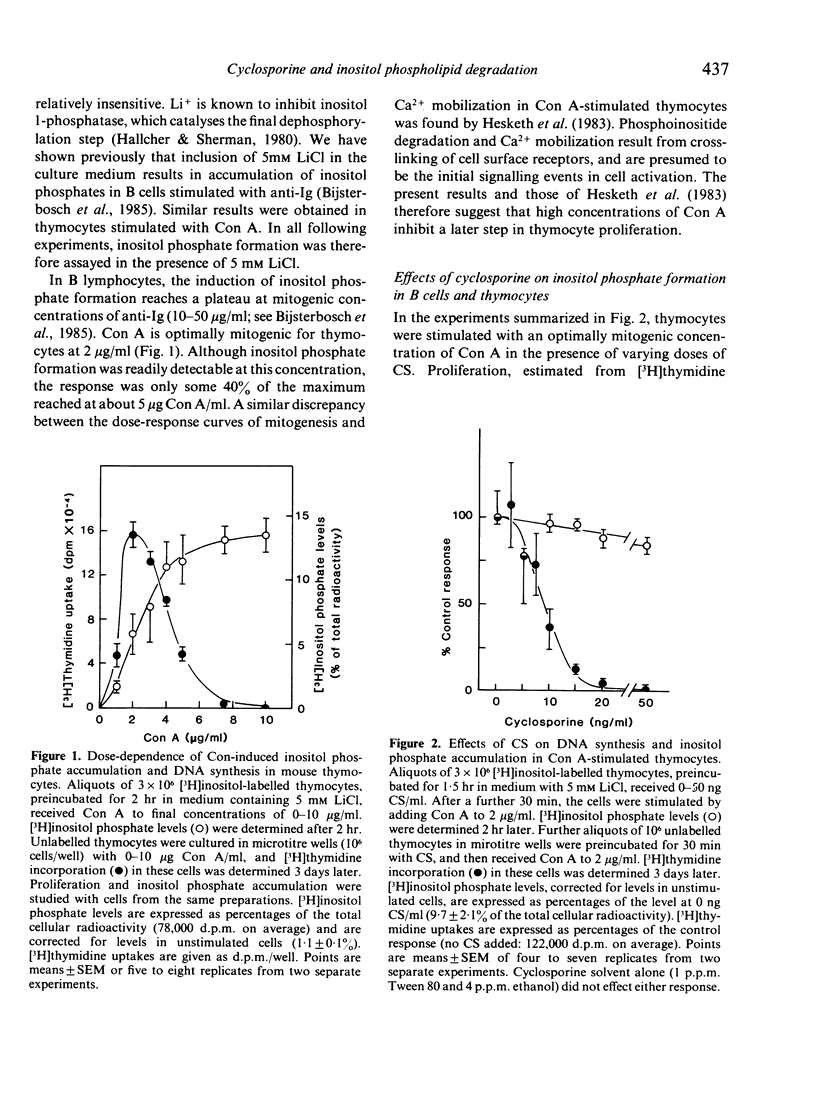
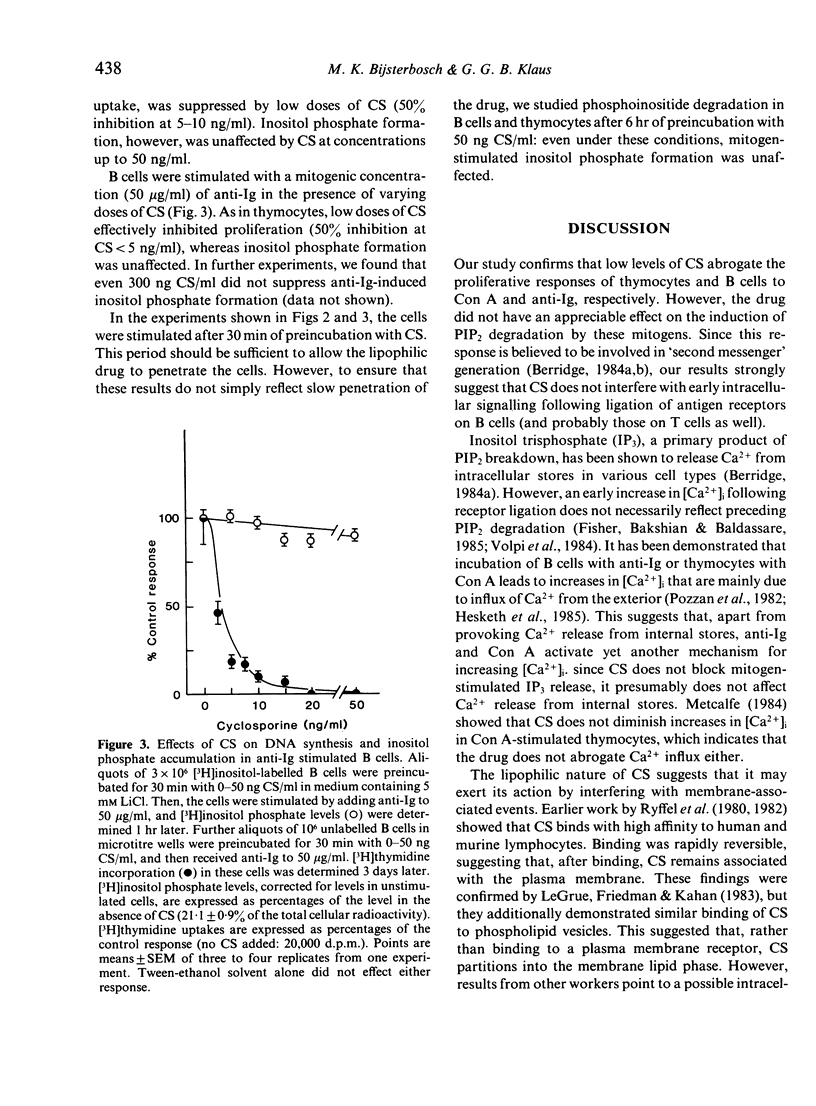
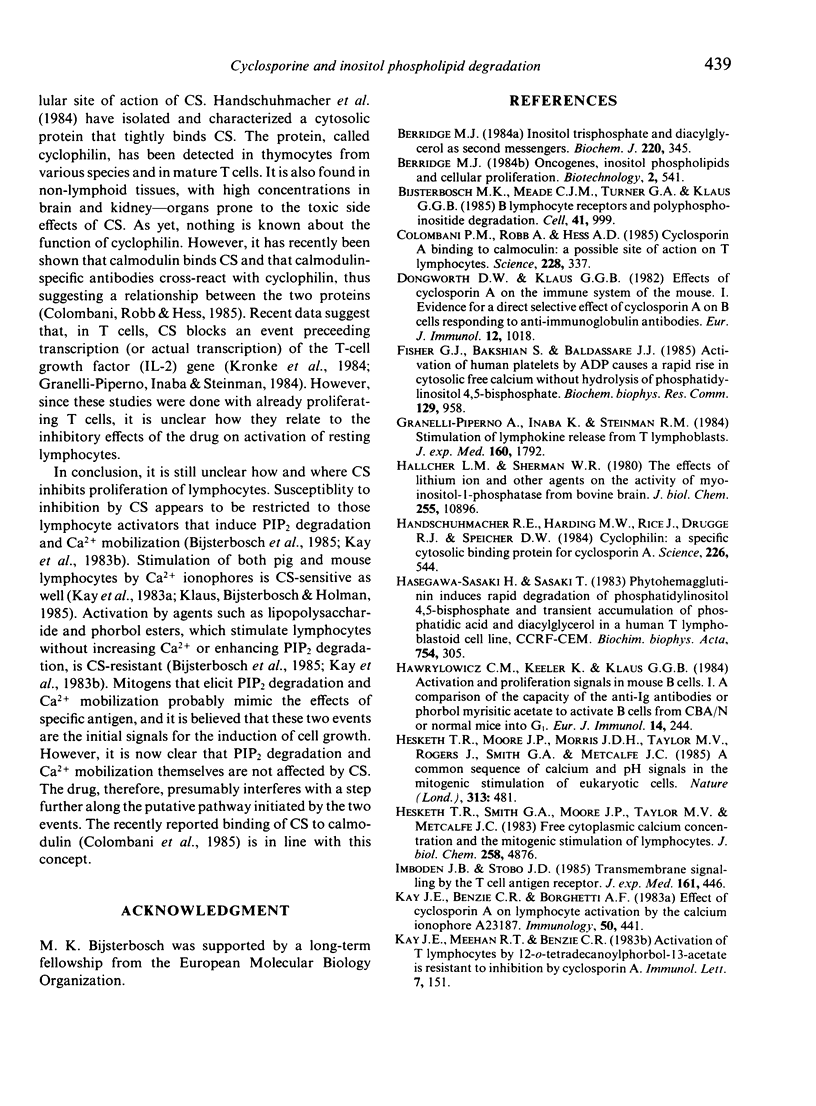
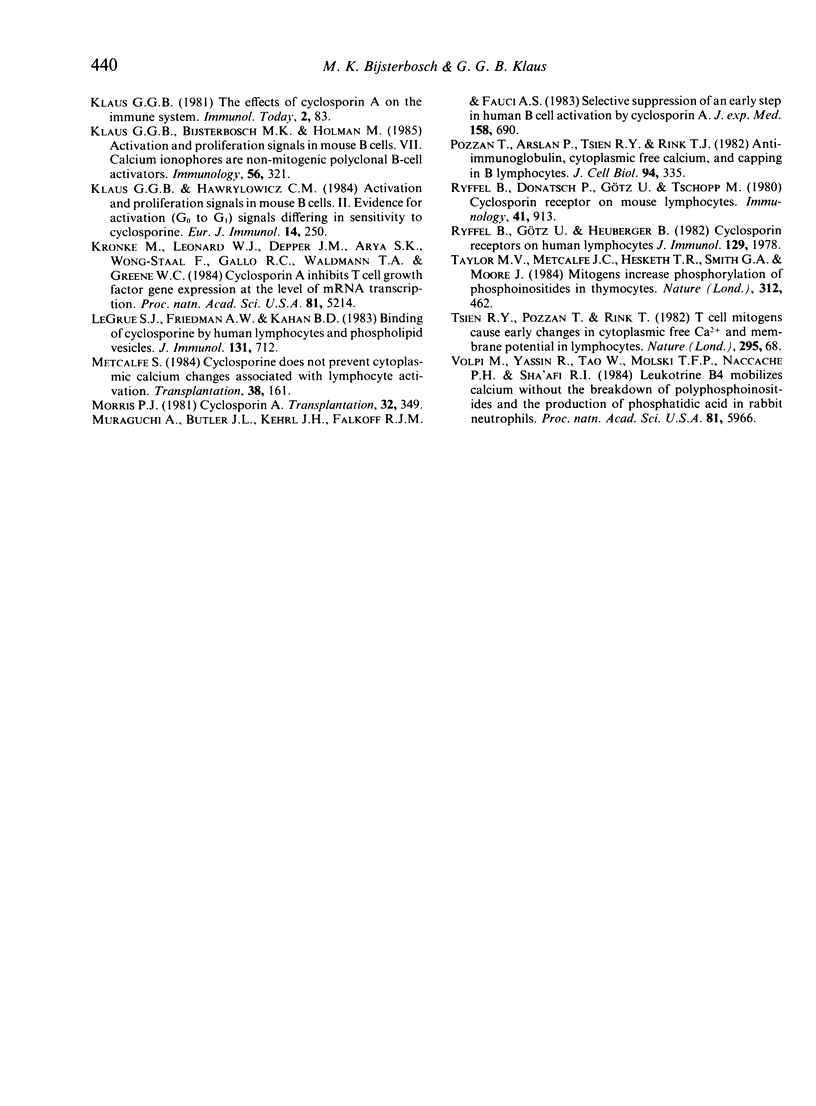
Selected References
These references are in PubMed. This may not be the complete list of references from this article.
- Berridge M. J. Inositol trisphosphate and diacylglycerol as second messengers. Biochem J. 1984 Jun 1;220(2):345–360. doi: 10.1042/bj2200345. [DOI] [PMC free article] [PubMed] [Google Scholar]
- Bijsterbosch M. K., Meade C. J., Turner G. A., Klaus G. G. B lymphocyte receptors and polyphosphoinositide degradation. Cell. 1985 Jul;41(3):999–1006. doi: 10.1016/s0092-8674(85)80080-5. [DOI] [PubMed] [Google Scholar]
- Colombani P. M., Robb A., Hess A. D. Cyclosporin A binding to calmodulin: a possible site of action on T lymphocytes. Science. 1985 Apr 19;228(4697):337–339. doi: 10.1126/science.3885394. [DOI] [PubMed] [Google Scholar]
- Dongworth D. W., Klaus G. G. Effects of cyclosporin A on the immune system of the mouse. I. Evidence for a direct selective effect of cyclosporin A on B cells responding to anti-immunoglobulin antibodies. Eur J Immunol. 1982 Dec;12(12):1018–1022. doi: 10.1002/eji.1830121207. [DOI] [PubMed] [Google Scholar]
- Fisher G. J., Bakshian S., Baldassare J. J. Activation of human platelets by ADP causes a rapid rise in cytosolic free calcium without hydrolysis of phosphatidylinositol-4,5-bisphosphate. Biochem Biophys Res Commun. 1985 Jun 28;129(3):958–964. doi: 10.1016/0006-291x(85)91984-9. [DOI] [PubMed] [Google Scholar]
- Granelli-Piperno A., Inaba K., Steinman R. M. Stimulation of lymphokine release from T lymphoblasts. Requirement for mRNA synthesis and inhibition by cyclosporin A. J Exp Med. 1984 Dec 1;160(6):1792–1802. doi: 10.1084/jem.160.6.1792. [DOI] [PMC free article] [PubMed] [Google Scholar]
- Hallcher L. M., Sherman W. R. The effects of lithium ion and other agents on the activity of myo-inositol-1-phosphatase from bovine brain. J Biol Chem. 1980 Nov 25;255(22):10896–10901. [PubMed] [Google Scholar]
- Handschumacher R. E., Harding M. W., Rice J., Drugge R. J., Speicher D. W. Cyclophilin: a specific cytosolic binding protein for cyclosporin A. Science. 1984 Nov 2;226(4674):544–547. doi: 10.1126/science.6238408. [DOI] [PubMed] [Google Scholar]
- Hasegawa-Sasaki H., Sasaki T. Phytohemagglutinin induces rapid degradation of phosphatidylinositol 4,5-bisphosphate and transient accumulation of phosphatidic acid and diacylglycerol in a human T lymphoblastoid cell line, CCRF-CEM. Biochim Biophys Acta. 1983 Dec 20;754(3):305–314. [PubMed] [Google Scholar]
- Hawrylowicz C. M., Keeler K. D., Klaus G. G. Activation and proliferation signals in mouse B cells. I. A comparison of the capacity of anti-Ig antibodies or phorbol myristic acetate to activate B cells from CBA/N or normal mice into G1. Eur J Immunol. 1984 Mar;14(3):244–250. doi: 10.1002/eji.1830140308. [DOI] [PubMed] [Google Scholar]
- Hesketh T. R., Moore J. P., Morris J. D., Taylor M. V., Rogers J., Smith G. A., Metcalfe J. C. A common sequence of calcium and pH signals in the mitogenic stimulation of eukaryotic cells. Nature. 1985 Feb 7;313(6002):481–484. doi: 10.1038/313481a0. [DOI] [PubMed] [Google Scholar]
- Hesketh T. R., Smith G. A., Moore J. P., Taylor M. V., Metcalfe J. C. Free cytoplasmic calcium concentration and the mitogenic stimulation of lymphocytes. J Biol Chem. 1983 Apr 25;258(8):4876–4882. [PubMed] [Google Scholar]
- Imboden J. B., Stobo J. D. Transmembrane signalling by the T cell antigen receptor. Perturbation of the T3-antigen receptor complex generates inositol phosphates and releases calcium ions from intracellular stores. J Exp Med. 1985 Mar 1;161(3):446–456. doi: 10.1084/jem.161.3.446. [DOI] [PMC free article] [PubMed] [Google Scholar]
- Kay J. E., Benzie C. R., Borghetti A. F. Effect of cyclosporin A on lymphocyte activation by the calcium ionophore A23187. Immunology. 1983 Nov;50(3):441–446. [PMC free article] [PubMed] [Google Scholar]
- Kay J. E., Meehan R. T., Benzie C. R. Activation of T lymphocytes by 12-O-tetradecanoylphorbol-13-acetate is resistant to inhibition by cyclosporin A. Immunol Lett. 1983;7(3):151–156. doi: 10.1016/0165-2478(83)90063-9. [DOI] [PubMed] [Google Scholar]
- Klaus G. G., Bijsterbosch M. K., Holman M. Activation and proliferation signals in mouse B cells. VII. Calcium ionophores are non-mitogenic polyclonal B-cell activators. Immunology. 1985 Oct;56(2):321–327. [PMC free article] [PubMed] [Google Scholar]
- Klaus G. G., Hawrylowicz C. M. Activation and proliferation signals in mouse B cells. II. Evidence for activation (G0 to G1) signals differing in sensitivity to cyclosporine. Eur J Immunol. 1984 Mar;14(3):250–254. doi: 10.1002/eji.1830140309. [DOI] [PubMed] [Google Scholar]
- Krönke M., Leonard W. J., Depper J. M., Arya S. K., Wong-Staal F., Gallo R. C., Waldmann T. A., Greene W. C. Cyclosporin A inhibits T-cell growth factor gene expression at the level of mRNA transcription. Proc Natl Acad Sci U S A. 1984 Aug;81(16):5214–5218. doi: 10.1073/pnas.81.16.5214. [DOI] [PMC free article] [PubMed] [Google Scholar]
- LeGrue S. J., Friedman A. W., Kahan B. D. Binding of cyclosporine by human lymphocytes and phospholipid vesicles. J Immunol. 1983 Aug;131(2):712–718. [PubMed] [Google Scholar]
- Metcalfe S. Cyclosporine does not prevent cytoplasmic calcium changes associated with lymphocyte activation. Transplantation. 1984 Aug;38(2):161–164. doi: 10.1097/00007890-198408000-00014. [DOI] [PubMed] [Google Scholar]
- Morris P. J. Cyclosporin A. Transplantation. 1981 Nov;32(5):349–354. [PubMed] [Google Scholar]
- Muraguchi A., Butler J. L., Kehrl J. H., Falkoff R. J., Fauci A. S. Selective suppression of an early step in human B cell activation by cyclosporin A. J Exp Med. 1983 Sep 1;158(3):690–702. doi: 10.1084/jem.158.3.690. [DOI] [PMC free article] [PubMed] [Google Scholar]
- Pozzan T., Arslan P., Tsien R. Y., Rink T. J. Anti-immunoglobulin, cytoplasmic free calcium, and capping in B lymphocytes. J Cell Biol. 1982 Aug;94(2):335–340. doi: 10.1083/jcb.94.2.335. [DOI] [PMC free article] [PubMed] [Google Scholar]
- Ryffel B., Donatsch P., Götz U., Tschopp M. Cyclosporin receptor on mouse lymphocytes. Immunology. 1980 Dec;41(4):913–919. [PMC free article] [PubMed] [Google Scholar]
- Ryffel B., Götz U., Heuberger B. Cyclosporin receptors on human lymphocytes. J Immunol. 1982 Nov;129(5):1978–1982. [PubMed] [Google Scholar]
- Taylor M. V., Metcalfe J. C., Hesketh T. R., Smith G. A., Moore J. P. Mitogens increase phosphorylation of phosphoinositides in thymocytes. 1984 Nov 29-Dec 5Nature. 312(5993):462–465. doi: 10.1038/312462a0. [DOI] [PubMed] [Google Scholar]
- Volpi M., Yassin R., Tao W., Molski T. F., Naccache P. H., Sha'afi R. I. Leukotriene B4 mobilizes calcium without the breakdown of polyphosphoinositides and the production of phosphatidic acid in rabbit neutrophils. Proc Natl Acad Sci U S A. 1984 Oct;81(19):5966–5969. doi: 10.1073/pnas.81.19.5966. [DOI] [PMC free article] [PubMed] [Google Scholar]


